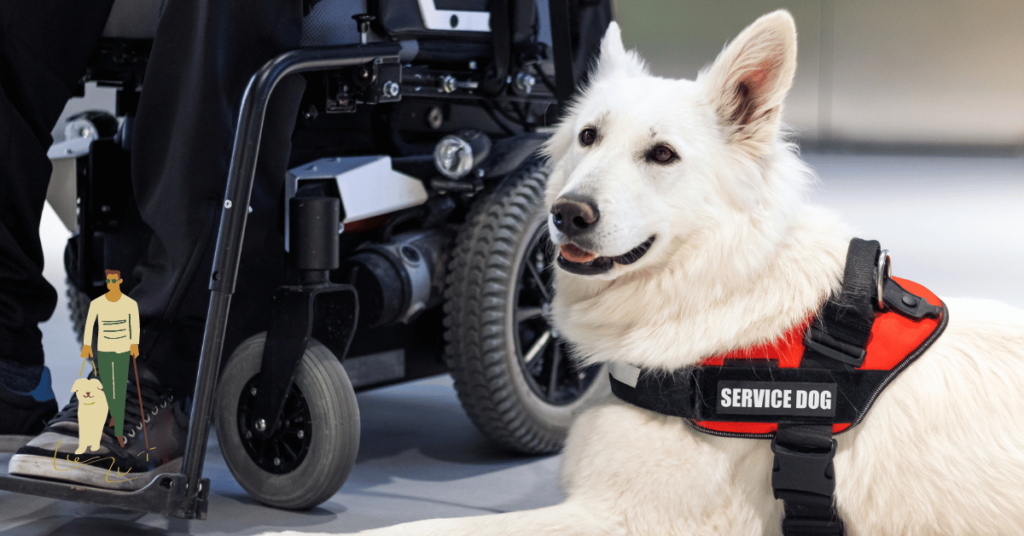Service dogs provide essential support to individuals with disabilities, assisting them in day-to-day activities. These dogs undergo extensive training to meet the specific needs of their handlers, whether it’s mobility assistance, guiding the visually impaired, or alerting someone to an upcoming medical episode.
While service dogs are invaluable, they come with significant costs, and unfortunately, health insurance doesn’t typically cover these expenses. However, there are other ways to manage the cost of obtaining and maintaining a service dog.
In this article, we will explore what insurance covers, what it doesn’t, and the alternative financial options available for service dog owners.
What Is a Service Dog?
A service dog is a specially trained animal that helps a person with disabilities perform tasks they cannot do on their own. According to the Americans with Disabilities Act (ADA), these dogs are not just pets; they provide essential services like:
- Guiding handlers around obstacles in public spaces
- Alerting hearing-impaired handlers to important sounds
- Offering balance support and helping with mobility tasks
- Detecting and responding to psychiatric episodes
- Going for help if their handler has a medical emergency, such as a seizure
Service dogs undergo rigorous training to perform these tasks, which makes them incredibly valuable. However, obtaining and maintaining a service dog is an expensive commitment.
Does Health Insurance Cover Service Dogs?
In general, health insurance plans do not cover the cost of obtaining, training, or maintaining service dogs. This includes the expenses associated with the purchase, training, and daily care of the dog. Most health insurance policies are limited to covering medical treatments and do not extend to animals, even if the animal is crucial to the owner’s well-being.
The one notable exception is the Department of Veterans Affairs (VA). The VA offers a veterinary health benefit for qualifying veterans who obtain service dogs through accredited organizations. This benefit covers the costs of routine veterinary visits, emergency care, and medication for service dogs. The service dog must come from an organization accredited by Assistance Dogs International (ADI) or the International Guide Dog Federation (IGDF).
How Much Does a Service Dog Cost?
The cost of a fully trained service dog can range from $15,000 to $30,000, though it can go as high as $50,000, depending on the breed and the level of specialized training required. These dogs undergo years of training to meet the specific needs of their handler, which contributes to the high price.
Additional Costs:
In addition to the initial cost of acquiring a service dog, there may be extra expenses, such as:
- Application fees from the service dog organization
- Travel expenses for you or the dog, especially if you need to attend training sessions far from home
- Ongoing training costs if the dog needs to learn new tasks or refresh its skills
Training the dog yourself could reduce these costs, but you would need to ensure the dog is properly trained for its role, which can be time-consuming and costly. Many people choose to hire professional trainers, which can cost between $10,000 and $30,000 for extensive training.
How Much Does It Cost to Maintain a Service Dog?

Once you have your service dog, there are ongoing maintenance costs, including:
- Food
- Veterinary care for routine checkups, vaccinations, and any accidents or illnesses
- Medication for heartworms, fleas, ticks, etc.
- Supplies like leashes, collars, vests, and beds
- Ongoing training to keep the dog sharp on its tasks
These expenses can range from $500 to $10,000 annually, depending on your dog’s health and the level of care required.
Can I Deduct Service Dog Expenses from My Taxes?
Yes, in some cases, expenses related to the purchase, training, and maintenance of a service dog can be deducted from your taxes, especially if the dog is assisting someone with vision, hearing, or other physical disabilities. It’s important to consult a tax professional to understand your eligibility.
Alternative Ways to Finance a Service Dog
While health insurance doesn’t typically cover service dogs, several alternative funding options are available:
1. Grants and Nonprofit Assistance
Numerous nonprofit organizations offer financial assistance or provide service dogs for free to qualified individuals. However, the waiting period for these programs can be long, sometimes taking years.
2. Crowdfunding
Many people turn to crowdfunding platforms to raise money for the cost of obtaining and caring for a service dog. Sites like GoFundMe can help you reach out to your community and beyond for financial support.
3. State and Federal Assistance
Some state and federal programs offer assistance. For example, the VA covers veterinary costs for veterans with service dogs. Additionally, states like California provide small monthly stipends (around $50) to help cover the cost of service dogs for individuals with disabilities.
4. Flexible Spending Accounts (FSA) and Health Savings Accounts (HSA)
You can use FSA, HSA, or Health Reimbursement Accounts (HRA) to cover some of the medical expenses related to your service dog, like veterinary care and medications, using pre-tax dollars.
5. Personal Loans
Some people opt to take out a personal loan to cover the initial costs of acquiring a service dog. While this option provides immediate funding, it’s important to remember that loans come with interest and must be repaid over time.
Pet Insurance for Service Dogs

Although health insurance won’t cover your service dog, you can purchase pet insurance to help with veterinary bills and other medical expenses for your dog. The three main types of pet insurance are:
- Accident-Only Coverage: Covers unexpected accidents like injuries but not illnesses.
- Accident and Illness (Comprehensive) Coverage: Covers accidents and illnesses, including treatments for conditions like cancer or diabetes.
- Wellness Coverage: Provides coverage for routine care, like vaccinations, check-ups, and preventive treatments.
The average annual premium for comprehensive dog insurance in 2022 was about $640. The cost of pet insurance depends on factors like the dog’s breed, age, and location.
Liability Insurance for Service Dogs
Although service dogs are trained to behave well in public, accidents can happen. Some homeowners and renters insurance policies include liability coverage in case your dog injures someone or damages property. However, some insurers may raise your rates if you own a breed they deem to be high-risk. You can also buy standalone liability insurance for your dog if your home insurance doesn’t offer enough coverage.
Life Insurance for Service Dogs
Another type of coverage you might consider is life insurance for service dogs. This can help cover the costs of euthanasia, cremation, or burial, as well as counseling for the handler after the dog passes away. Life insurance for pets typically costs between $250 and $900 per year, depending on the dog’s health, age, and value.
Conclusion
While health insurance generally does not cover service dogs, there are alternative ways to finance the cost of acquiring, training, and maintaining a service animal. Nonprofit organizations, grants, and state or federal assistance can help reduce the financial burden, while pet insurance can protect you from unexpected veterinary expenses. If you’re considering a service dog, it’s important to explore all your options to ensure your furry companion gets the care they need while staying within your budget.
So that was all about this article. If you have any further questions feel free to comment down below. We are always here to help you!




